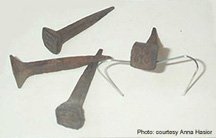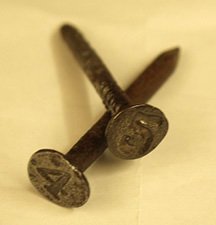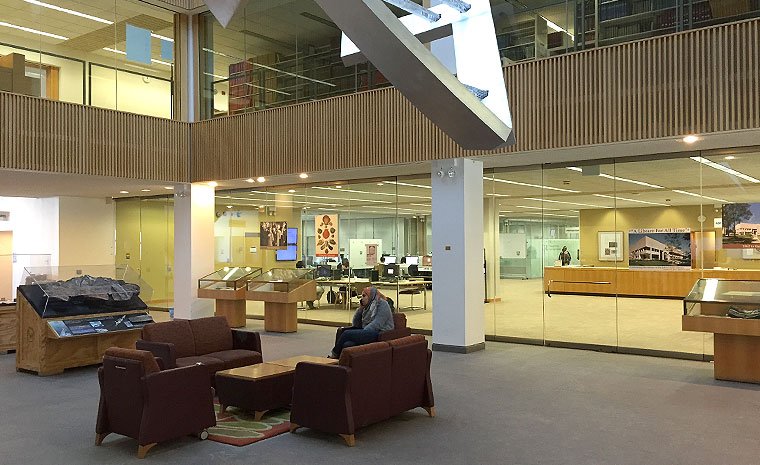Accomplishments
- A pioneer builder and modern thinker of the American railroad system, Chanute surveyed, built and upgraded railroad lines, as well as designed and constructed two major stock yards, in Chicago and Kansas City.
- A structural engineer, first built wood, then iron trestle bridges with foundations over some of the most difficult natural barriers, like the Missouri River at Kansas City, the Illinois River at Peoria, and the Genesee River Gorge near Portageville, NY.
- An urban planner who plotted villages along newly established railroad lines (Fairbury, IL and Chanute, KS), developed and implemented sanitary water supplies (and returns!) to homes and stock yards. He researched and co-authored a developmental study on the elevated railway system (i.e. rapid transit in New York), a system that was built many years later.
- An environmentalist and chemist to whom forest preservation was important. He and his partner (later on Chanute’s own son became his partner), started a wood preservation company in timber used for railroad tie and bridge construction. Later he introduced the railroad “date nail” to the United States, there making it possible to record the age and viability of preserved railroad ties.
- Among the major authorities on aeronautical research and engineering at the turn of the century. As a practical aeronautical engineer, he designed the world’s most successful heavier-than-air aircraft prior to the Wright’s inventions of 1901 and 1903.
Octave Chanute introduced the railroad date nail into the United States, whereby it was possible to record the age and viability of preserved railroad ties. “I think the better way may be to use a galvanized tack, such as our friend here, Mr. Chanute has devised, with date on head….” stated W.C. Curtis of the Southern Pacific at the 1900 A.R.E.A. meeting.
What are date nails? A “date nail is a nail with the date stamped in its head. For example, a nail with a "41" is from 1941. They are usually 2 1/2" long, with 1/4" shanks. Date nails were driven into railroad ties, bridge timbers, utility poles, mine props, and other wooden structures for record keeping purposes.” - Jeff Oaks
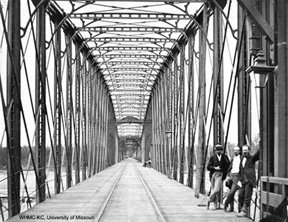
Published in 1870. Courtesy of the Western Historical Manuscript Collection-Kansas City.
Looking north along the bridge, showing left to right: George Morrison, Assistant Engineer; Octave Chanute, Chief Engineer; Joseph Tomkinson, Superintendent of Superconstruction. Picture photocopied from Octave Chanute’s book Kansas City Bridge with an account of the regimen of the Missouri River, and a description of the methods used for founding in that river.
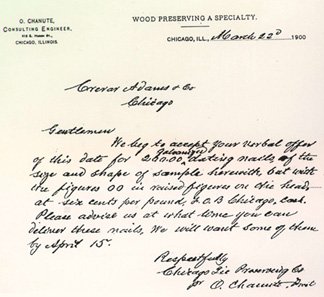
Adams and Co., Chicago, IL, 1900.
Courtesy of the Octave Chanute Papers, Manuscript Division, Library of Congress, Washington, D.C.

Rascher, Charles. 1890. Courtesy of the Library of Congress, Geography and Map Division.
Chanute entered a competition early in 1865 to design the Chicago Union Stock Yards (pictured on the left). He won with his design and the yards were built later in 1865.The Kansas City Stockyards were designed and built by Chanute in 1871.
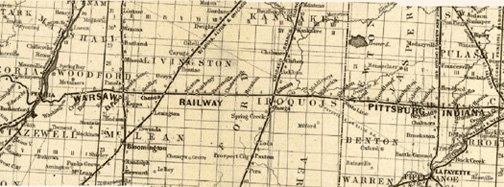
G.W. & CB Colton & Co., 1867. Courtesy of the Library of Congress, Geography and Map Division.
Sectional map of the state of Illinois. Chanute surveyed and laid out the line from Peoria to the Indiana border (112 miles) in 1857. Chanute also plotted the town of Fairbury about the same time.
